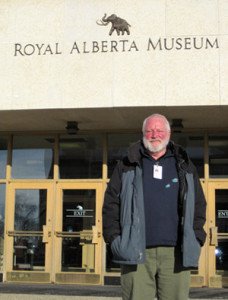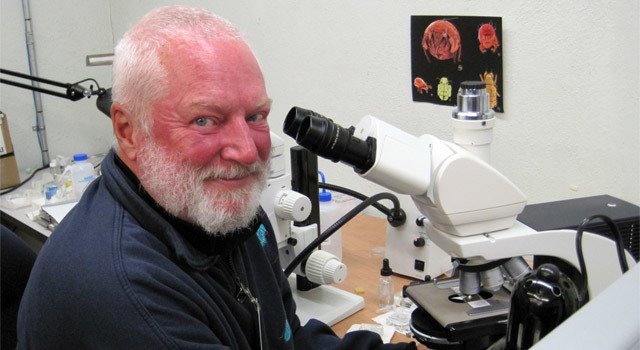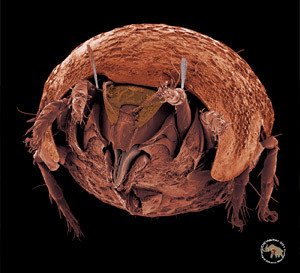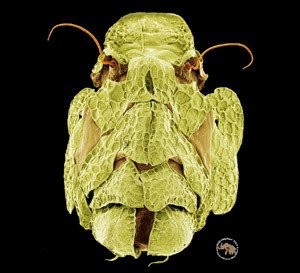Acarologist (mite expert) Dave Walter “retires” from the ABMI; joins University of the Sunshine Coast, Queensland.
 To say that acarologist Dr. Dave Walter wrote the book on mites (Acari) would be no cliché. In fact Walter, who “retires” as the ABMI’s acarologist and taxonomic advisor this month, is co-author of six and author of three of the 16 chapters of the field’s Bible, A Manual of Acarology, which he edited with the University of Oregon’s Gerald Krantz. With the third edition now in print, this ten-year labour of love is, one could argue, his magnum opus.
To say that acarologist Dr. Dave Walter wrote the book on mites (Acari) would be no cliché. In fact Walter, who “retires” as the ABMI’s acarologist and taxonomic advisor this month, is co-author of six and author of three of the 16 chapters of the field’s Bible, A Manual of Acarology, which he edited with the University of Oregon’s Gerald Krantz. With the third edition now in print, this ten-year labour of love is, one could argue, his magnum opus.
But that’s before you look at his other many significant contributions to the field in a 35-year career: Walter has over 150 peer-reviewed publications to his name; he’s the editor-in-chief of the International Journal of Acarology; co-author (with Heather Procter) of the text book Mites: Ecology, Evolution and Behaviour (2nd Ed.) published this year; as well as being the indefatigable creator and custodian of the Almanac of Alberta Oribatida, a lavishly-illustrated, living compendium detailing over 300 species of moss and beetle mites that live in Alberta’s ecosystems.
He’s become expert at illustrating mites too, painstakingly manipulating their images in Photoshop to reveal their natural colours, and their seemingly infinite variety. As an added feather in his cap, his true-to-life illustrations of mites have come to light in publications as varied as the academic journal Science, the more homespun Popular Science, and even The Times (UK) newspaper’s educational supplement. Naturally, they grace his text books too.
His world-class taxonomic expertise has proved invaluable to the ABMI’s biodiversity monitoring program, with which he’s been associated since 2007. “There’s plenty of interest in biodiversity now and especially concern about loss of species. But unless you can identify them, you’d never know that you had them, let alone that you’ve lost them,” says Walter. “Taxonomy,” he says, “is at the base of all the natural sciences, the essential component. If you didn’t have this knowledge, you couldn’t get anything done.”
Walter’s curiosity about mites began 35 years earlier, when, armed with an undergraduate degree in entomology from the University of Maryland, he took a position at the Division of Biological Control at the University of California. “We were looking at the western pine beetle and the predators and parasites associated with it, to find natural ways of controlling it in trees like the Ponderosa pine,” says Walter. “They gave me samples of pine litter, which nobody had been able to do anything with. I found I had a knack for seeing differences amongst tiny, little things. I found that in a handful of Ponderosa pine litter, you can extract a hundred species of mite easily,” Walter enthuses, adding that mites aren’t all tiny. They range from the lumbering moose tick (“a giant blood-sucking mite,” says Walter) at two centimetres when engorged, to a mere 50 microns (less than a tenth of millimeter).
After taking a summer acarology program at Ohio State University—the only place in the US that offers the specialized training—Walter took a master’s degree at California State University, then cast about looking to learn more. He chanced upon Gerry Krantz at Oregon State University, who had published the first edition of A Manual of Acarology. “So, I just drove up to Oregon State University in Corvallis, showed up in the office, and said, ‘Hi, I want to study mites.’ And that’s how I got started,” he says.
With a PhD under his belt, Walter struck out for Colorado and a post-doctoral fellowship at the Natural Resources Ecology Laboratory in the Systems Ecology Group. “It was a great opportunity to work with people who worked with nematodes (roundworms), protozoa, fungi and bacteria in the soil to figure out how these food webs were maintaining the fertility of the shortgrass prairie/dryland wheat ecosystems,” he says.
After five years, he traversed the US again, this time bound for the United States Department of Agriculture (USDA) in Florida, looking at the biocontrol of nematode pests in citrus trees. And here, a serendipitous turning point occurred in the form of a letter from Monash University in Melbourne, Australia wondering if he knew of a postdoc who’d like an interesting position.
“I thought, ‘why would I give this to a student?’ I’ll do it.”
And so Walter left for Australia, falling in love with its warmth, beauty, generous people—and the opportunity to study mites in rainforest habitats. When the University of Queensland was looking for an acarologist, Walter leapt at the chance to take up a professorship there. “I went from working in soils in the shortgrass prairie into the canopy of rainforests, just following the mites,” he says.
When he returned to Canada 15 years later, the ABMI was just developing its protocols and Walter, who is also adjunct professor in the Department of Biological Sciences at the University of Alberta, dived in, taking on the task of classifying the enormous variety of Alberta’s mites. To date, he’s classified about 350 of them—about 15 per cent of them never described. And that, he says, “is simply because Alberta hadn’t been looked at very much—and nobody had looked at the boreal forest. We know a lot about mites in the Arctic, but no one wants to go sampling in the boreal, mucking through the muskeg. It’s hard terrain.”
Walter says the importance of mites for soil health can’t be underestimated. They’re critical to the nutrient cycling process essential to the planet’s ecosystems. “The soil is a living thing and the mites, microbes and springtails—they make it alive.” And that makes life on earth possible.
Now Walter is on to a new adventure, heading to Australia where an adjunct professorship awaits at the University of the Sunshine Coast in Queensland. And he already has contacts at the Queensland Museum. “So it’s not like I’m going to stop doing acarology,” he says with a smile. “It’s simply that I’m going to be doing Australian acarology.”
“So, I suppose for me ‘retirement’ just means I can concentrate on doing the things I want to do. And if I lay on the beach a couple of days a week, well, I’ll just have to put up with it!”
From everyone at the ABMI, Dave, our grateful thanks for your gifts of knowledge and dedication over the years. We wish you happy trails, and a mite-y happy retirement.
Learn more about Alberta’s mites at The Royal Alberta Museum.



